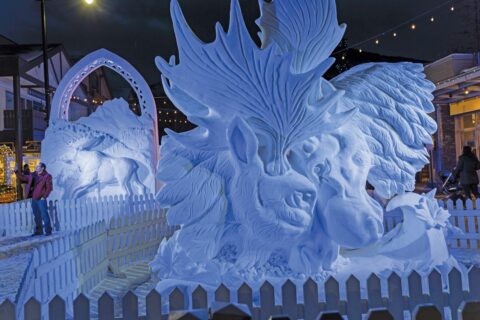People move to the Bow Valley for a variety of reasons, but those who stay are drawn to the dramatic mountain landscapes, the connection to nature, and the coexistence with wildlife. While everyone loves seeing our wild neighbours, we must also respect that we are in their space. Mountain residents should learn to understand wildlife behaviour and needs so we can all enjoy our mountain home together. There is lots of information out there on etiquette around wildlife, but here are a few key species and what to look out for.
Bears
Here in the Bow Valley, we love our bears. If you’ve lived here for any amount of time you know about the antics of The Boss and Split Lip and you probably know where the mamas and babies are during the spring and summer. Unfortunately, our behaviour directly affects the well-being of our resident wild bears, and we often cause them stress or even harm through our actions.
It’s important to give bears space. Lots of space. And it’s also safe to assume they are being badgered by tourists looking to get their Instagram shot. Despite your best efforts, you could encounter a bear who is already frazzled by human encounters, and he’s ready to bluff charge the next human he sees.
Carrying bear spray and knowing how to use it is the best way to stop an attack, but preventing it in the first place should be everyone’s priority. Make sure you’re aware when you’re out on the trails, travel in groups, and make noise. Respect trail closures – they’re in place for your safety, as well as the bear’s. During the fall, clean fruit off your trees so bears aren’t attracted into town, where they almost always get into trouble!
Elk
If you live in the valley, you probably know where the elk are on any given day. If you’ve only ever visited, you’ve likely seen the herds moving around the townsites, munching on grass, or sleeping in the sunshine. They’re known to use the crosswalks better than tourists, and these large ungulates can form personal connections with the community. Sometimes they even have names, like Marvin, who made the local paper when he passed away peacefully of old age in a resident’s back yard.
Despite their popularity with locals and tourists alike, elk will charge and attack, particularly during the fall and spring. In the fall, rutting males bugle and challenge other males with their impressive antlers. While the sound of the bugle is a sign of the changing seasons, these boys are looking for a fight, and they won’t tolerate anyone close by. In the spring, mama elk hide their babies in the trees and step out to the meadows to eat. It may look like the babies are on their own, but Mom is keeping a close eye, and she won’t tolerate anyone coming between her and her young.
If you do see the elk, make sure to give them space and don’t get in the middle of the herd.
Sheep
If you’ve made the drive up to Norquay on a local’s day, or you’ve travelled between Canmore and Exshaw, you’ve definitely come across some bighorn sheep. These stout critters like to lick the salt on the roads, and they really don’t care if you’re late for work, or you’re excited to hit the slopes. While they seem steadfast and aloof, it’s important to give these animals space. As with all wild animals, they can be dangerous, particularly in the spring when they’re protective over their young, or in the fall when they can become aggressive during the rut.
When it comes to all wild animals, and bighorn sheep in particular, it’s important you have your dog on a leash at all times. Sheep see dogs as predators and can charge and attack them if provoked. Their large horns can do damage, so it’s best to keep your pup close and give sheep their space so they can get on with their business.
It’s also important to look up when walking along rock cuts or other rocky areas that extend overhead. Bighorn sheep, and mountain goats higher up, often travel along rocky ledges and dislodge rocks that can fall on the trail.
Cougars
These large cats are seldom seen, but evidence of them is prevalent throughout the area. Canmore’s Cougar Creek got its name for a reason! Cougars are generally aloof and prefer to stay hidden, but that doesn’t mean they aren’t aware of you passing through. They travel great distances, and it’s not always known if they’re in the area.
Cougar encounters are rare, but it’s important to keep pets and small children close by, as they are most at risk. If you do see a cougar, pick up small children or pets, make yourself appear as large as possible, make noise, and back away slowly. Don’t turn and run as this can trigger a chase.
It’s more common to see evidence of cougars than the actual cat, so watch out for scat, prints, or flocks of ravens, which may indicate a kill site and a predator nearby. Cougars sometimes bury their food, or they may drag it up a tree, so it’s often hard to spot. If you come across signs, leave the area to give these wild cats their space.
Both Alberta Parks and Parks Canada will put out cougar warnings if they know one is in the area. Either organization may close trails if the cougar has a food cache nearby, or they suspect some other issue might arise. Even if there are no posted warnings, it’s always best to travel in groups, make noise, keep pets on a leash, and keep children close by. Always be observant of your surroundings.
We all love the mountains, and we all want to coexist with wildlife who live in the area. It’s important to remember this is their home too! With a little bit of effort, we can all enjoy our mountain home together.



